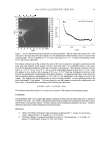J. Cosmet. Sci., 60, 1–5 (January/February 2009) 1 A comparison of females and males for antiperspirant effi cacy and sweat output JAMES P. BOWMAN and JOHN E. WILD, Hill Top Research, Main and Mill Streets, Miamiville, OH 45147, KATHRYN SHANNON, Hill Top Research, 3225 N. 75th Street, Scottsdale, AZ 85251, and JOANNE BROWNE, Hill Top Research, 6699 13th Avenue N, St. Petersburg, FL 33710. Accepted for publication September 29, 2008. INTRODUCTION An antiperspirant product is an OTC (over-the-counter) drug and is regulated by the Food and Drug Administration (FDA). In order to be labeled an antiperspirant, a product must be formulated within the Category I guidelines of the Antiperspirant Drug Products for Over-the-Counter Human Use monograph (1) and must be tested according to these guide- lines as well. The product must reduce axillary perspiration to a level that is statistically signifi cantly greater than 20% reduction. The primary aim of this research was to compare the antiperspirant effi cacy achieved be- tween male and female test subjects using the same test product within each study. The secondary objective was to compare the baseline sweat output of males and females who had been exposed to the same heat stimulus. MATERIALS AND METHODS Eight antiperspirant effi cacy studies were included in this review. The FDA monograph procedure (1,2) was utilized in each study. There were slight modifi cations in the specifi c designs of the individual studies however, all study designs met monograph requirements. The test procedures for all studies are outlined as follows: CONDITIONING PERIOD Each subject was provided with a deodorant product to use for underarm odor protection, as needed, for a period of at least 17 days prior to enrollment. Use of axillary antiperspi- rant products was discontinued during this period.
JOURNAL OF COSMETIC SCIENCE 2 BASELINE SWEAT COLLECTION Gravimetric baseline sweat values were determined and used to compare the differences be- tween the highest and lowest average rate of sweat output among the test subjects. The FDA monograph (2) requires that within a selected panel of test subjects, the difference between the subject with the highest rate of sweat and the subject with the lowest rate of sweat must exceed 600 mg of sweat/20 min/axilla during the baseline sweat collections. In addition, a subject must produce ≥ 100 mg of sweat/20 min/axilla during the baseline sweat. SUPERVISED AXILLARY WASHES A mild bar soap was used for all supervised axillary washes. Supervised axillary washes were conducted prior to each test article application. TEST ARTICLE APPLICATION Assignment of test articles and placebo was randomized to the right and left axilla. Sub- jects in each study received approximately four daily treatment applications (two studies required only two applications). The test articles were applied at a rate appropriate for the product form and were applied to uniformly cover approximately a 4×6-inch area cen- tered in the axillary vault. No other axillary products were permitted to be used during the active treatment period. SWEAT COLLECTION INTERVALS Sweat collections were conducted at baseline and approximately one and 24 hr following application No.4 for six of the studies and approximately one hour after application No. 2 for two of the studies. SWEAT STIMULATION Sweating was induced by having the subject sit erect in a room maintained at 100°F ± 2°F, with the relative humidity in the range of 30% to 40%. SWEAT COLLECTIONS During the initial 40 minutes of the sweat stimulation period, the subject held un- weighed pads of Webril (non-woven cotton padding fabric) in their axillae. This pre- liminary warm-up period was followed by two successive 20-min collection periods, during which the subjects held weighed Webril pads in the axillae. These pads were weighed in tightly capped polystyrene vials before and after use. The vials were labeled with the subject’s number and axilla and collection designation. The fi rst collection made with weighed pads was designated Collection B and the second Collection C.
Purchased for the exclusive use of nofirst nolast (unknown) From: SCC Media Library & Resource Center (library.scconline.org)

















































































